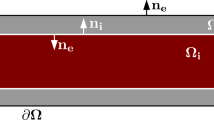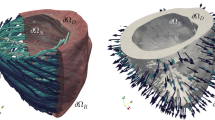Abstract
The numerical solution of the coupled system of partial differential and ordinary differential equations that model the whole heart in three dimensions is a considerable computational challenge. As a consequence, it is not computationally practical—either in terms of memory or time—to repeat simulations on a finer computational mesh to ensure that convergence of the solution has been attained. In an attempt to avoid this problem while retaining mathematical rigour, we derive a one dimensional model of a cardiac fibre that takes account of elasticity properties in three structurally defined axes within the myocardial tissue. This model of a cardiac fibre is then coupled with an electrophysiological cell model and a model of cellular electromechanics to allow us to simulate the coupling of the electrical and mechanical activity of the heart. We demonstrate that currently used numerical methods for coupling electrical and mechanical activity do not work in this case, and identify appropriate numerical techniques that may be used when solving the governing equations. This allows us to perform a series of simulations that: (i) investigate the effect of some of the assumptions inherent in other models; and (ii) reproduce qualitatively some experimental observations.
Similar content being viewed by others
References
cellML. http://www.cellml.org/examples/repository/index.html#cardiac_ep_models.
Choi, B.-R., Salama, G., 2000. Simultaneous maps of optical action potentials and calcium transients in guinea–pig hearts: mechanisms underlying concordant alternans. J. Physiol. 529, 171–88.
Costa, K.D., Holmes, J.W., McCulloch, A.D., 2001. Modelling cardiac mechanical properties in three dimensions. Philos. Trans. Roy. Soc. Lond. A 359, 1233–250.
Janz, R.F., Kubert, B.R., Moriarty, T.F., 1974. Deformation of the diastolic left ventricle—II. Nonlinear geometric effects. J. Biomech. 7, 509–16.
Guccione, J.M., Costa, K.D., McCulloch, A.D., 1995. Finite element stress analysis of left ventricular mechanics in the beating dog heart. J. Biomech. 28, 1167–177.
Hunter, P.J., Nash, M.P., Sands, G.B., 1997. Computational electromechanics of the heart. In: Panfilov, A.V., Holden, A.V. (Eds.), Computational Biology of the Heart. Wiley, West Sussex.
Hunter, P.J., McCulloch, A.D., ter Keurs, H.E.D.J., 1998. Modelling the mechanical properties of cardiac muscle. Prog. Biophys. Mol. Biol. 69, 289–31.
Hunter, P.J., Pullan, A.J., Smaill, B.H., 2003. Modelling total heart function. Annu. Rev. Biomed. Eng. 5, 147–77.
Keener, J.P., Sneyd, J., 1998. Mathematical Physiology. Springer, New York.
Makridakis, C.G., 1993. Finite element approximations of nonlinear elastic waves. Math. Comput. 61, 569–94.
Morton, K.W., Mayers, D.F., 1994. Numerical Solution of Partial Differential Equations. University Press, Cambridge.
Nash, M.P., Hunter, P.J., 2000. Computational mechanics of the heart. J. Elast. 61, 113–41.
Nash, M.P., Panfilov, A.V., 2004. Electromechanical model of excitable tissue to study reentrant cardiac arrhythmias. Prog. Biophys. Mol. Biol. 85, 501–22.
Nickerson, D.P., 2004. Modelling cardiac electro-mechanics: from cellML to the whole heart. PhD thesis, University of Auckland.
Nickerson, D.P., Smith, N.P., Hunter, P.J., 2005. New developments in a strongly coupled cardiac electromechanical model. Europace 7, S118–S127.
Niederer, S.A., Hunter, P.J., Smith, N.P., 2006. A quantitative analysis of cardiac myocyte relaxation: a simulation study. Biophys. J. 90, 1697–722.
Noble, D., Varghese, A., Kohl, P., Noble, P.J., 1998. Improved guinea-pig ventricular cell model incorporating a diadic space, I Kr and I Ks , and length- and tension-dependent processes. Can. J. Cardiol. 14, 123–34.
Remme, E.W., Nash, M.P., Hunter, P.J., 2005 Distributions of myocyte stretch, stress and work in models of normal and infarcted ventricles. In: Kohl, P., Sachs, F., Franz, M.R. (Eds.), Cardiac Mechano-Electric Feedback and Arrhythmias: From Pipette to Patient. Saunders–Elsevier, UK.
Schneider, W., Bortfield, T., Schlegel, W., 2000. Correlation between CT numbers and tissue parameters needed for Monte Carlo simulations of clinical dose distributions. Phys. Med. Biol. 45, 459–78.
Simnett, S.J., Johns, E.C., Lipscomb, S., Mulligan, I.P., Ashley, C.C., 1998. Effect of pH, phosphate, and ADP on relaxation of myocardium after photolysis of diazo 2. Am. J. Physiol. Hear. Circ. Physiol. 275, 951–60.
Smith, N.P., Nickerson, D.P., Crampin, E.J., Hunter, P.J., 2004. Multiscale computational modelling of the heart. Acta Numer. 13, 371–31.
ten Tusscher, K.H.W.J., Noble, D., Noble, P.J., Panfilov, A.V., 2004. A model for human ventricular tissue. Am. J. Phys. Hear. Circ. Physiol. 286, 1573–589.
Whiteley, J.P., 2006. An efficient technique for the solution of the monodomain and bidomain equations. IEEE Trans. Biomed. Eng. 53, 2139–147.
Usyk, T.P., Mazhari, R., McCulloch, A.D., 2000. Effect of laminar orthotropic myofiber architecture on regional stress and strain in the canine left ventricle. J. Elast. 61, 143–64.
Author information
Authors and Affiliations
Corresponding author
Rights and permissions
About this article
Cite this article
Whiteley, J.P., Bishop, M.J. & Gavaghan, D.J. Soft Tissue Modelling of Cardiac Fibres for Use in Coupled Mechano-Electric Simulations. Bull. Math. Biol. 69, 2199–2225 (2007). https://doi.org/10.1007/s11538-007-9213-1
Received:
Accepted:
Published:
Issue Date:
DOI: https://doi.org/10.1007/s11538-007-9213-1




